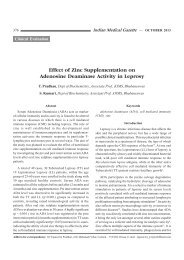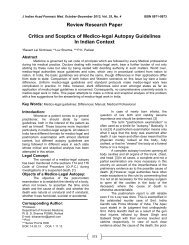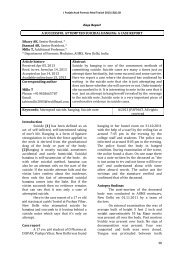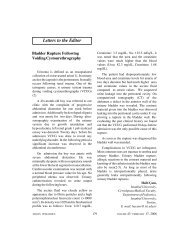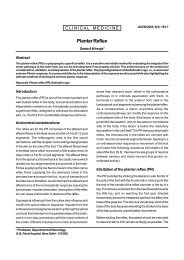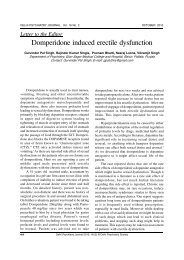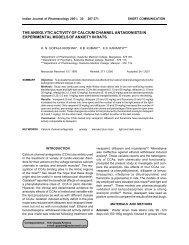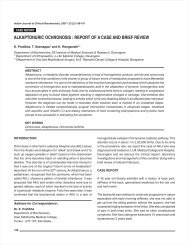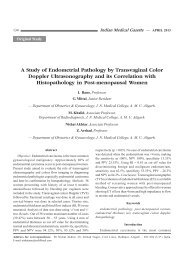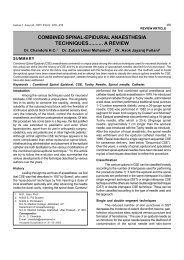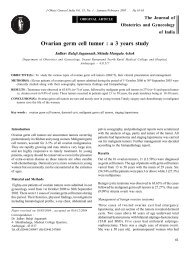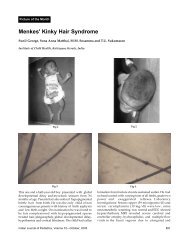Diabetic Neuropathy: Current Concepts - medIND
Diabetic Neuropathy: Current Concepts - medIND
Diabetic Neuropathy: Current Concepts - medIND
You also want an ePaper? Increase the reach of your titles
YUMPU automatically turns print PDFs into web optimized ePapers that Google loves.
and adolescents with type 1 diabetes.<br />
However, there are two important problems<br />
in QST, firstly, QST is only a semi-objective<br />
measure, and can be influenced by both<br />
attention and motivation of the patient and<br />
secondly, abnormal results from QST can<br />
result from spinal cord pathology as well as<br />
cortical lesions. Thus, QST though sensitive<br />
for peripheral neuropathy, is not specific for<br />
this condition.<br />
Treatment of diabetic neuropathy<br />
Definitive prevention, treatment, or cure of<br />
diabetic peripheral neuropathies must await the<br />
discovery of the exact aetiology and effective<br />
treatment of diabetes, however, the results of<br />
DCCT and pancreas transplantation studies on<br />
peripheral neuropathy clearly demonstrate that<br />
an effective and early treatment of<br />
hyperglycaemia is currently the only important<br />
factor in delaying the progression of<br />
neuropathy. The asymmetric and focal<br />
neuropathies are either self-limiting or do not<br />
respond to any treatment modality. So treatment<br />
is largely directed towards distal symmetric<br />
sensori-motor polyneuropathies and for<br />
symptoms related to autonomic neuropathy.<br />
The treatment of diabetic neuropathy can be<br />
broadly divided into two major groups : (i)<br />
Symptomatic treatment (ii) Treatment for nerve<br />
regeneration.<br />
Symptomatic treatment<br />
Pain is the most common symptom, which could<br />
be superficial, deep, or aching. The management<br />
of pain is often difficult and disappointing. There<br />
is no single correct approach to the management<br />
of any given patient with peripheral neuropathy.<br />
Often it requires patience on the part of patient<br />
and physician who must try a variety of different<br />
medications on a trial and error basis until a<br />
satisfactory regimen is established. Sometimes<br />
simple reassurance that the pain is not permanent,<br />
does produce great relief from pain, pain related<br />
anxiety, or depression. However, following<br />
measures can be taken in order of preference for<br />
pain relief :<br />
Capsaicin<br />
Superficial hyperaesthesia with burning and<br />
lancinating dysaesthetic pain is typical of c-fibre<br />
pain and may respond to local application of<br />
capsaicin. Capsaicin is trans-8methyl-N vanilly-<br />
6-nonemide 45 . Capsaicin is extracted from chilli<br />
pepper and can be prepared at home by mixing<br />
three teaspoons of cayenne pepper with a jar full<br />
of cold cream. Its topical application results in<br />
depletion of substance P, a principal neurotransmitter<br />
of poly model nociceptive afferent<br />
fibres. The mechanism of substance P depletion<br />
may be secondary to the release of substance P<br />
from nerve terminals, diminished axonal transport<br />
of substance P to replenish it in the nerve terminals,<br />
and inhibition of its synthesis 45 . Capsaicin is<br />
applied at a dose of 0.075%, four times a day to<br />
skin over the painful areas. The reported controlled<br />
studies suggest that the benefits of drug application<br />
become evident only after four weeks of its use.<br />
Analgesics<br />
The analgesics do not have a good reputation in<br />
the management of diabetic neuropathy. On one<br />
end they have poor efficacy and at the other end<br />
they have adverse effects. Long term NSAID<br />
ingestion causes hepatotoxicity, while narcotic<br />
analgesia causes addiction and worsening of<br />
autonomic neuropathic symptoms.<br />
Tricyclic anti-depressants (TCA)<br />
Tricyclic anti-depressants (TCA) are the most<br />
commonly used drugs for pain relief in diabetic<br />
peripheral neuropathy. Double blind trials of<br />
the tricyclic anti-depressants have demonstrated<br />
significant benefits in reducing pain that is<br />
burning, aching, sharp, throbbing, or stinging 46 .<br />
The use of amitriptyline is contraindicated in<br />
patients with heart block, recent myocardial<br />
infarction, heart failure, urinary tract<br />
obstruction, orthostatic hypotension, and<br />
narrow angle glaucoma. It should be started at<br />
312 Journal, Indian Academy of Clinical Medicine Vol. 2, No. 4 October-December 2001



